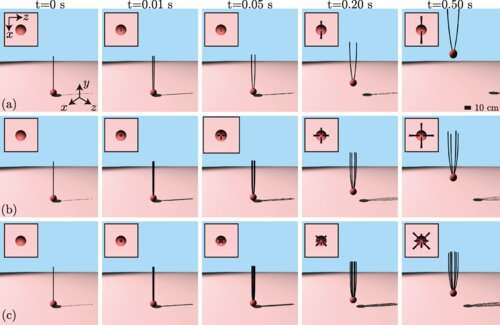March 10, 2022 report
Simulations suggest electrostatic forces could push some spiders airborne

A pair of researchers, one with Notre Dame University-Louaize, the other the University of California, has developed a model that suggests some small spiders may become airborne due to electrostatic forces acting on multiple spider-generated threads. In their paper published in the journal Physical Review Letters, Charbel Habchi and Mohammad Khalid Jawed, describe how they used data from prior experiments and an algorithm developed by the movie industry to accurately portray animated hair to simulate "ballooning" in spiders.
Ballooning in spiders is where threads they generate pull them up into the air—similar to how a human might be yanked up into the air when holding onto a very large helium-filled balloon. Scientists from many different fields have speculated on the mechanics at work with ballooning. One of the most popular theories suggests that rising air from a surface warmed by the sun pushes threads upward, carrying the spider along with them. In this new effort, the researchers started with the idea that it seemed more likely that ballooning comes about due to electrostatic forces in the atmosphere exerting influence on multiple spider threads that are all attached to the spider.
The team started with the knowledge that there is always present in the atmosphere some degree of a vertical electric field. Realizing that it would be extremely difficult to test the idea of such an electric field yanking spiders skyward, they instead created a model to show that it should be possible. They fed real-world parameters to an algorithm commonly used in the movie business to generate animated hair as it is impacted by the wind. The algorithm in turn, divided multiple strands of thread into bits that could be twisted, stretched and bent. To simplify the action, a spider was represented by a simple red sphere. As the simulation ran, the spider generated several strands of thread each of which was imbued with an electrical charge, resulting in all of them reaching skyward. At a certain point, the charge became strong enough that the threads bulbed out at the top, forming an upside-down cone. Eventually, the threads and spider were lifted upwards allowing the spider to float on the wind. The flight lasted until downward drag and the weight of the spider overcame the electrostatic charge. The researchers note that the combined characteristics of the threads and the electrostatic force kept the threads from tangling.
More information: Charbel Habchi et al, Ballooning in spiders using multiple silk threads, Physical Review E (2022). DOI: 10.1103/PhysRevE.105.034401
Journal information: Physical Review Letters , Physical Review E
© 2022 Science X Network





















